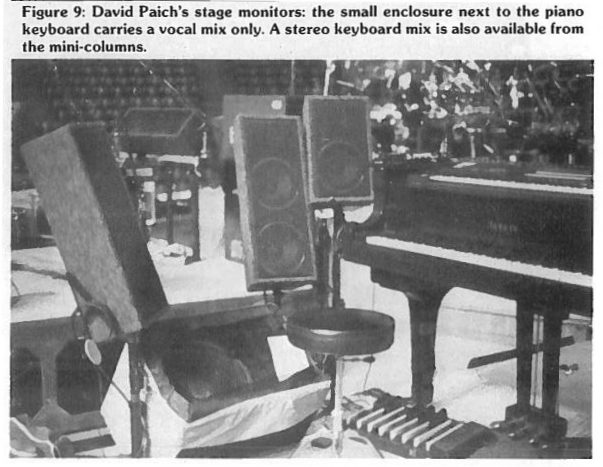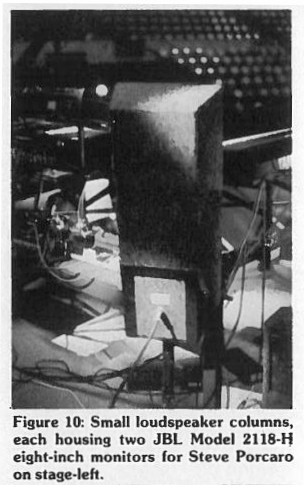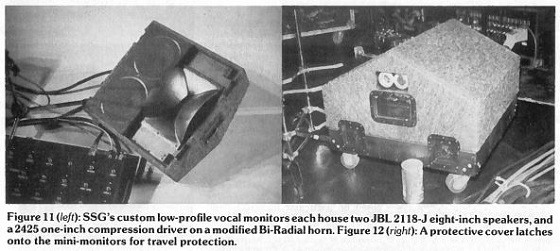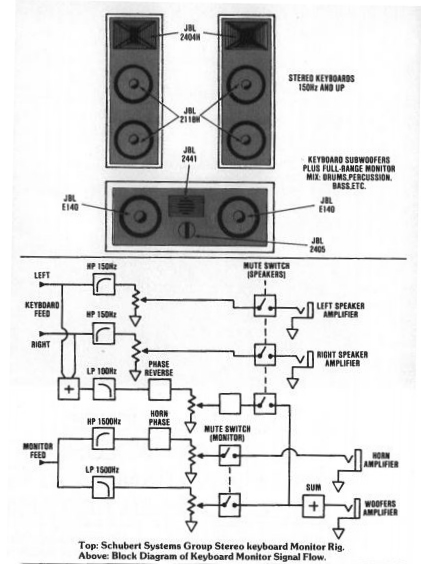
Keyboard Monitors
“An important part of assembling this stage-monitoring system was the concept that the performers wanted small, bright-sounding boxes placed up at ear level,” explains designer Dirk Schubert.
“Also, nobody in this band wants to hear much of anything below 150 Hz on the vocals coming from these boxes. It is like a ‘closefield’ mini-monitor approach. What we basically had to come up with was the Yamaha NS-IO or JBL 4401 speaker concept that could put out concert sound pressure level an be able to hold up on the road.”
Sets of compact, custom-built stereo keyboard monitors and interface electronics were designed and assembled by Schubert Systems Group to present the complex mixes to the performers.
For console monitoring, both David Bowers (stage-right) and Ed Simeone (stage-left) used a pair of cabinets that were identical to those placed on stage.
The miniature loudspeaker columns each house two J BL Model 2118H eight-inch speakers with a passive contour network on each, and a 2404H tweeter.
The eight-inch speaker’s frequency response is essentially flat from 150 Hz to 4 kHz, at which point the tweeter is brought in with a passive crossover network.
The boxes are trapezoidal in shape, and fitted into the stage set with small metal support stands (Figure 10). Yamaha PC-2002 amplifiers power the keyboard rigs, while Metron A-400 amps drive the vocal monitors.
The small keyboard columns proved 80 popular during rehearsals that other performance areas also were supplied with them, including the sax/background vocal riser.
“The concept really makes sense,” explained sideman Scott Page.
“The little boxes give us bright reference information to sing with, right there in front of us. The kick and bass sound, the main rhythm section mix, comes from a little farther away in the bigger slant, instead of blasting me in the face like a lot of stage speaker system do. It works great.”
Critical keyboard, vocal and solo instrument program information is fed through the compact speakers.
Figure 11 (left): SSG’s custom low-profile vocal monitors each house two JBL 2118-J eight-inch speakers, and a 2425 one-inch compression driver on a modified Bi-Radial horn. Figure 12 (right): A protective cover latches onto the mini-monitors for travel protection.
Additional rhythm section material requiring better low-frequency presentation is fed to the various performers through separate larger floor slant monitors that house JBL K-140 15-inch speakers, 2441 drivers with 2445 diaphragms, and 2405 tweeters.
Where floor monitors are required for vocals, including Steve Lukather and Mike Porcaro, SSG’8 low-profile vocal slant monitors were used (Figure 11).
These tiny boxes pack a pair of JBL 2118-J eight-inch speakers and a 2425 one-inch compression driver mounted on a modified JBL 2344 BiRadial horn.
Actively crossed over at 1.5 kHz, the cabinets sit hardly 12 inches high, and offer an extremely smooth, yet bright, vocal reference mix; they also have a power contour network on the horn.
A protective cover latches into place for travel, and wheels make moving the package very easy. (Figure 12)




